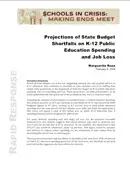Nearly all state budgets are in the red, suggesting looming cuts and possible job loss in K-12 education. New estimates of shortfalls in state revenues and K-12 staffing data enable early projections of the magnitude of both the impact on K-12 public education spending and corresponding job loss. These projections can help policymakers at all levels understand the size and scope of the problem as they work to craft next steps.
Assuming the absence of intervention via increased taxes or federal stimulus spending, this analysis projects an 18.5 percent drop in state funds for K-12 education from 2009 budgeted figures to FY 2011, creating an 8.7 percent drop in total public education spending over the same period. The implication is that states will spend a total of $54 billion less on public K-12 education during the 2009 and 2010 calendar years than if spending had been held at budgeted FY 2009 levels. That number jumps to $80 billion for state spending on K-16 education, if higher education spending projections are included.
For many districts, spending cuts will imply job loss. For the projected shortfalls modeled here, this analysis suggests that school districts may need to eliminate just over 9 percent of total jobs in K-12 education. In raw numbers, the implication is that 574,277 jobs would be eliminated during the three school years, many via attrition. That figure, however, assumes that districts do indeed reduce spending via the elimination of jobs, rather than by shortening the school year or reducing pay.
These projections include only the effects of shortfalls at the state level. With 44 percent of total K-12 education spending generated at the local level, any shortfalls at the local level will further aggravate the fiscal effects for districts.




